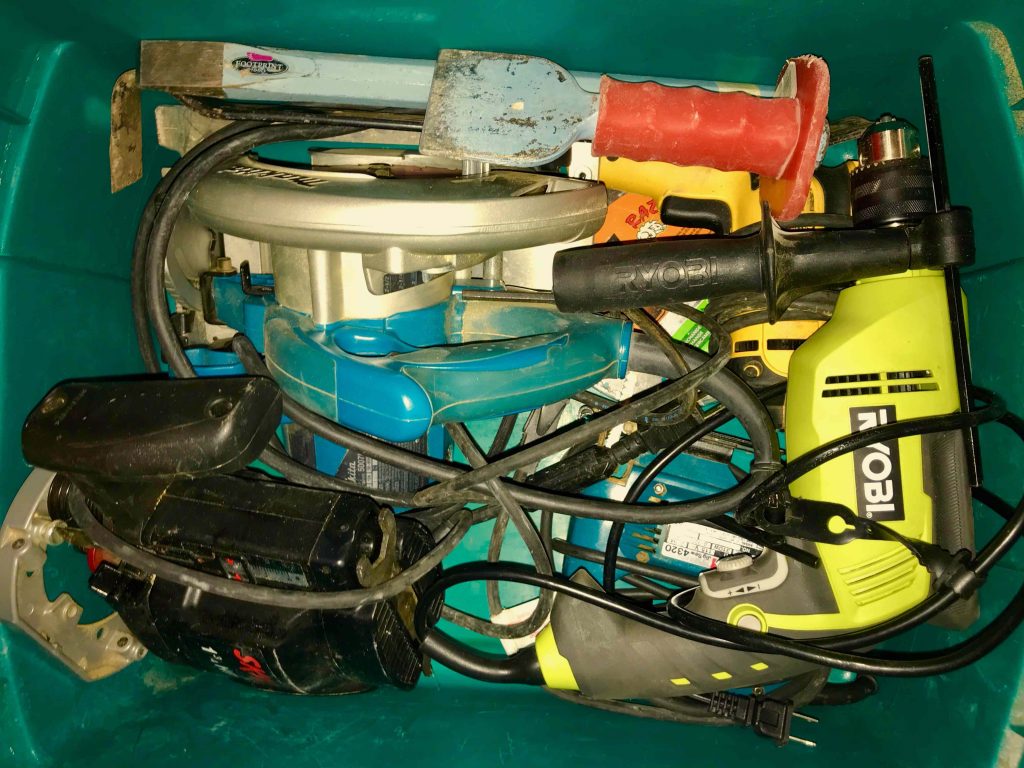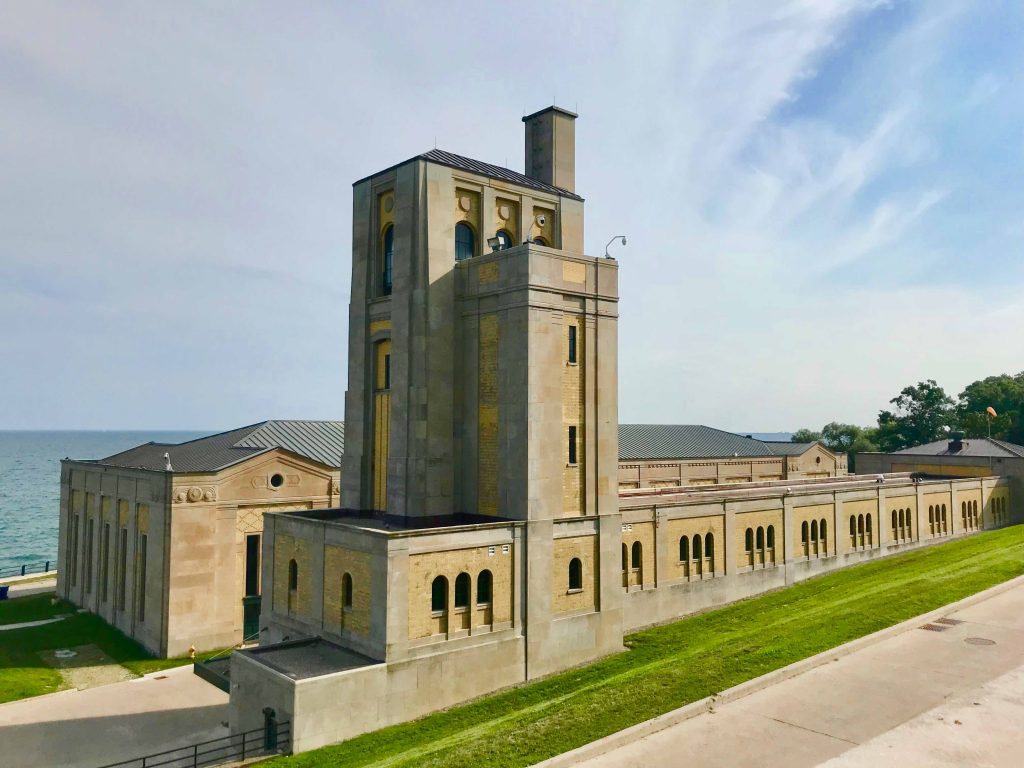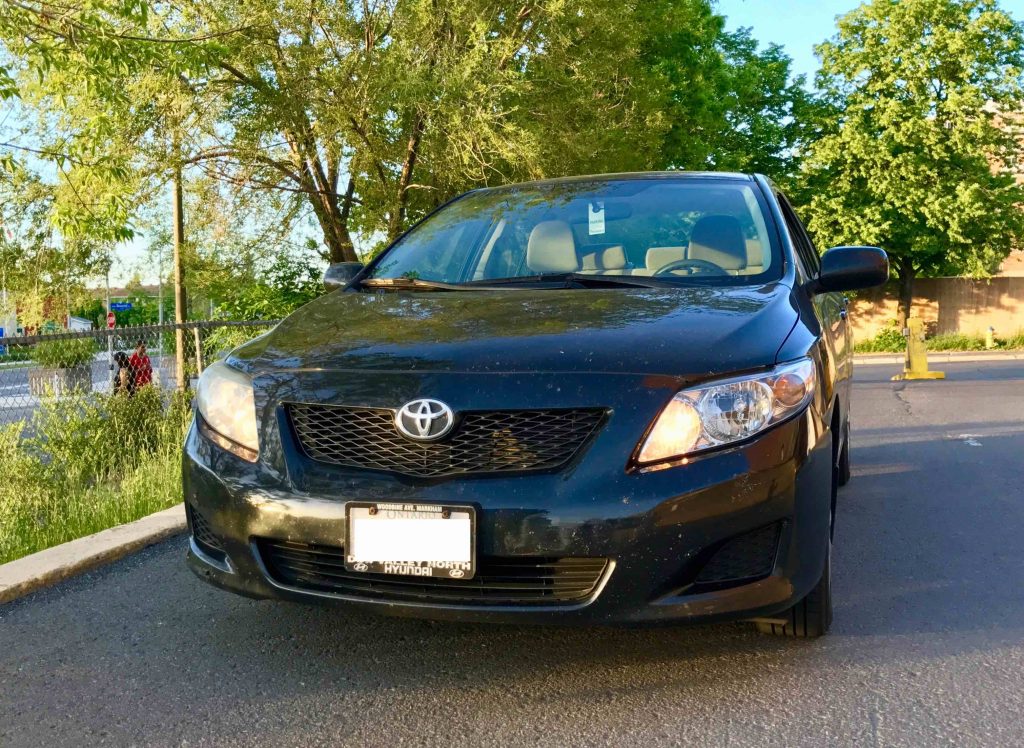I made a bad decision in the summer before my senior year of college. It could have been a total disaster,
Behold the beautiful RC Harris waterworks building. Built in 1930, it was dubbed the Palace of Water. With marble interior, gleaming brass fixtures and an Art Deco style, it has earned its historic building status. Despite its advanced years, the plant still produces 800 million litres a day of fresh, clean drinking water. I live across the street from it, so I see a daily reminder of how lucky we are to have a virtually unlimited supply of the life-giving nectar. Could this water plant be a reminder of how to tap into easy savings?
At current rates, water costs about $3.80 for a cubic meter. That’s a lot of water. Putting it into terms we can relate to, filling a one litre bottle costs about 1/3 of a cent. Quite economical. Especially when you compare that to, say Dasani bottled water which is also made from, well, tap water and costs about $2 at retail. And what to make of those souls lugging cases of bottled water from Costco to minivan, then minivan to driveway and driveway to kitchen, typically somewhere near the faucet. Yes, the thing that spouts the unlimited supply. Splurge on a fancy stainless steel water bottle, and enjoy some fresh tap water while saving the oceans from some polyethylene terephthalate that they don’t really need.
Picture a 17 pound block of sugar
But people don’t just drink water. they drink a lot of soft drinks. In 2018 we will drink about 65 litres of the stuff per person. Thats about 200 cans of pop for each of us. Which you can think of as us consuming about 7.8 kg of sugar (picture a 17 lb weight plate at the gym – not that they come in that size). 200 cans of pop holds about 30,000 calories or enough to help us each gain 8.6 lbs a year. If you are drinking the diet version, you will save the sugar, but you may be embalming your body with a curious mix of chemicals. Cost wise, these 200 cans of pop add about $400 year which we could all put to better use.
Looking at a typical fast food lunch, the “entre” is somewhere around $8-$10 but the drink adds another $2. So swapping out the drink for plain water is another way to tap into easy savings. It’s like having a 20% discount card at every restaurant in town. And the drink may be adding 15 – 20% of the calories as well, and loading you with sugar that you can do without. Ask them to put the water into your refillable bottle, saving them the cost of the cup and the earth the extra landfill. If they whine about giving you tap water explain that you need it to take your pills.
Sparkling, glacier fed, oxygenated, imported or tap?
At high end restaurants, they love to get the fancy water flowing to swell the cheque size. Up selling. Some restaurants run contests around it to optimize profits. Others actually “make’ their own signature water. When the question comes, request tap water. Maybe add a bit of lemon. Won’t affect the conversation, the business deal or the taste of the food. Another way to tap into easy savings.
An easy habit to change
CBS recently reported that 75% of Americans fall short of the recommended 10 cups of water a day. Time to hydrate. I know, water is a bit boring. Add some ice. If you substitute tap water enough times, everything else will seem too sweet, your health will benefit and you will free up bit of cash for debt repayment or incremental savings. Switching to water works the same as changing any habit. More on that here.
Have you switched to tap water? Still stuck drinking pounds of sugar a year? Let me know!
Have a look at the parking lot of one of those suburban mega-restaurant-outdoor malls on a Friday night. You know, the ones with the Moxies, Milestones, Keg, Jack Astors and…well you get the idea. The asphalt is adorned with beautiful cars. Shiny, late model Bimmers, Acuras and Lexus SUVs. Who is driving all of them? How is it that they are all driving the perfect car? And how come they can afford them and we can’t?
The simple answer is that they aren’t affording them. The average car loan is now 69 months. That is insane. It has been steadily rising. People then leave car loans early to get a nicer car and carry their negative equity over to another new car loan. Interest on the interest. Logic out the window. The marketing machine and our peers have convinced us all what we need and to not worry about paying for it. It is, in fact, time to worry. So what is the perfect car and how do we find it?
The Acura vs Honda experiment
I recently moved from an Acura MDX to a Honda CRV. I was curious what would happen if I made the switch. It was fascinating. Nothing happened. Same friends. Same fun road trips. My kids still speak to me. Solid safe driving. It doesn’t accelerate as quickly, but that doesn’t really change the outcome of my grocery trips or business meetings. It likely saves about $4,000 a year vs the more luxurious MDX. My favourite new features? Runs on regular gas, cheaper insurance, half the fuel cost, lower servicing costs. And it has every kind of feature and drives great. I lost some prestige and the ability to carry an extra couple of people for when I need to do that twice a year. I’ll ship them in an Uber for an extra $50 a year. They’ll be fine. As a financial speaker and writer, I am likely better off with less prestige.
So what is the perfect car and how do you find it?
Start with the question of whether you need a car or not. Can you locate closer to your work? Carpool? Walk? Bike? Can you Uber around the rest of the time? Cars are a massive expense and doing without one and using the savings for debt repayment or increased investment is a powerful way to get ahead.
If you can’t avoid one, aim for the simplest, most reliable one you can find. The black Toyota Corolla in the picture is a great example. My son bought it as a 4 year old used car when he graduated. Lived frugally and paid the whole thing off in a few months. Runs like a dream. As a software engineer, could he have handled the payments on a Bimmer? Sure. But why? The CaRolls Royce (as he calls it) has manual winder windows, hub caps and a pretty spartan interior. Would father and son trips be more fun in a nicer car? I doubt it. What would have been the Bimmer payments are in his TFSA, compounding nicely. In one simple move, he gets a safe reliable ride and starts a path to financial freedom. And he is sure that his dates are interested in him, not his Corolla.
Where do you find the reliable ones? Easy. Subscribe to Consumer Reports Online. $25 a year. One of the great bargains. Look up the cars you are interested in and check the reliability score. Couldn’t be simpler. My CRV was their second best pick for small SUVs. I will admit that I liked the look of it better than their top pick.
How much can you afford for a car?
How much can you afford? I like the concepts on the interest.com site. Check out their post on how much car you can afford. They talk about a 20/4/10 rule, meaning to put down at least 20%, pay it off in less than 4 years and not pay more than 10% of your gross compensation for car payments and insurance. Good advice.
On affordability, don’t push your budget upward because your budget can handle the extra payment dollars. Think about your finances in terms of your net worth over time. In other words: What is the car decision that will optimize your wealth over the long term? Learn more about that here.
Once you get the car, take the time to do the scheduled maintenance. The newer cars tell you when they need help. Heed the call. It will save you in the long run.
So what is the perfect car?
The perfect car is one that gets you there safely and optimizes your wealth over the long term by being cheap to operate, reliable and have reasonable servicing costs. And even with Bluetooth connectivity, GPS mapping with traffic and route optimization, heated steering wheels, adjustable lumbar support and sculpted alloy rims, there is still one car feature that turns a good car a perfect car. The lack of a monthly payment.
What are your tips for finding and driving the perfect car? Let me know in the comments.
It happened again. This time, I was out for a drink with my daughter’s boyfriend’s dad. (How many of us can say that!) Great guy. He brought it up first. He is transitioning from the bicycle industry to real estate. “It’s like serendipity”, he said, “I just keep meeting the right people at the right time who are there to help me.” I smiled and nodded, “Go on”. He offered story after story. He has tapped into the power and is in awe of the possibilities.
I have seen it non-stop since I left the land of the quarterly earnings. I am living a constant Field of Dreams moment. My car dealer friend introduced me to another self-published author and speaker who agreed to share his secrets over a coffee. I couldn’t type fast enough into my iPhone. He laid out his whole business model for me and has followed up with emails to keep me on point. No charge, no consulting fee, no catch. Just doing it for the goodness of paying it forward. But it’s not just him. Old friends are reappearing. Colleagues offer introductions that pave the way for new possibilities. Sometimes it is me, sending drops of serendipity their way. And finding oceans of it washing back in return.
Where is all of this serendipity coming from?
And the serendipity breeds more serendipity. The speaking engagement leads to a newspaper column. The blog post leads to a speaking engagement with the clients of a financial advisor, which then leads to an employee financial wellness session at a different firm.
Was it always there and I missed it? Are we rising toward peak serendipity? Just yesterday, at a client meeting we talked about what we could do together on social media. One idea flowed into the next. Some would help my business, some would help theirs. Didn’t matter. There was a “pull” feel to it. No pushing, no demanding, no measurement. Just people helping people and the results flowing in. In fact, it seems to happen the most, the further I get from the command and control corporate world. Speaking with entrepreneurs, they look at me like I’m from Saturn. Of course that is how things get done. They have known about it all along.
How to open the serendipity tap?
So how can we all grow some more serendipity in our lives? I am no serendipity expert, but let me share what I have seen so far:
- Do Good – Choose a vocation that is about helping others. Define a great quest. It feels good and draws in others to help.
- Be Open – Accept the invitation even if it’s not clear why you should go. It could be a dinner in Toledo or a coffee in Portland that opens up completely new possibilities for you.
- Seek to Help – Meet new people with a mindset of how you can help them in their journey. Seek to understand, then to be understood.
- Look for the Synergies – Is there an elegant meeting of needs somewhere that can accelerate what you both are doing? What unique properties do you each have that can help the other?
- Loosen the Strings – in the corporate world, it is often about bolting down timelines and deliverables. Let them flow for a while and see what happens.
- Connect Others – we are all just a connection or two away from meeting those who can help our plans soar. Keep bringing your contacts together and those synergies will flow among them. And back at you.
Do you find Serendipity is rising? Or are we becoming more attune to it? Share your thoughts!
Photo credit Louis K on Unsplash




